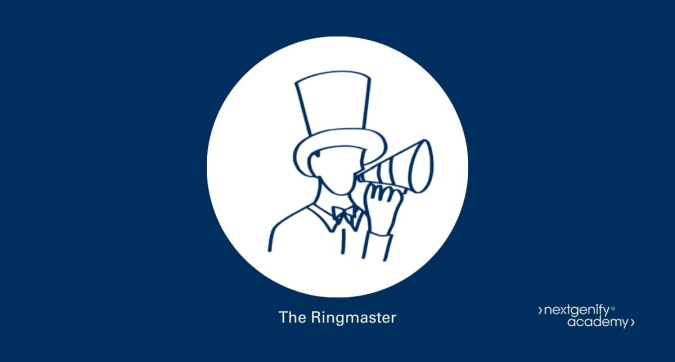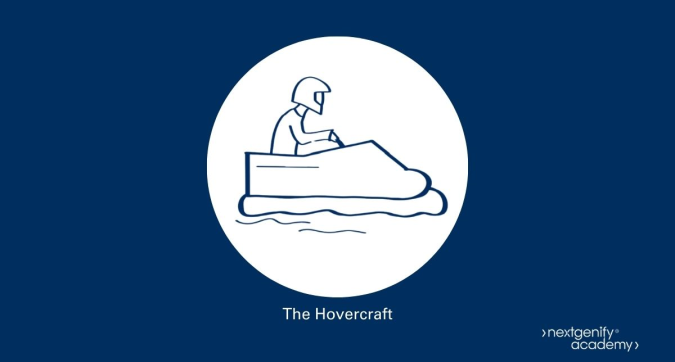The 5 types of bad bosses and how to deal with each (an unbossing guide)

29 August 2025
By Cherie Mylordis
We’ve all worked with them. Under pressure, some of us even become them. Not because we’re bad people but because we default to the leadership patterns we’ve experienced ourselves.
But I’m not here to bash bad bosses. I’m here to hold up a mirror that helps us all do better.
When you can spot these patterns – whether in your manager or, let's be honest, in yourself – you can consciously choose a better way.
Or as I like to call it, you can start to unboss yourself.
How to use this guide
For each bad boss archetype, I’ll show you how to:
- Spot the signs: So you can think: ‘Ah yes, that’s my manager’… or ‘Ouch, is that actually me?’
- Consciously unboss yourself: Simple swaps you can make this week to break the pattern
- Influence up: Kind but credible ways to nudge your boss without overstepping boundaries
- Helpful tools: All available inside nextgenify’s Leadership Academy
Understand the 5 bad boss archetypes
1. The Ghost Boss

You're chasing clarity, but they keep evaporating. Your one-on-ones mysteriously slide off the calendar, decisions float in limbo, and when the pressure mounts, your messages seem to disappear into a void while the team flies blind.
Then—plot twist—when the work is finally done, they materialise in the spotlight to claim credit. Or worse, they point fingers at the gaps and ask you, ‘How on earth did this happen?’
Spot the signs
- Check-ins are irregular or frequently vanish from calendars.
- Their Teams status seems permanently set to ‘away’.
- Priorities feel fuzzy, and the definition of ‘done’ keeps shifting.
- Decisions arrive late… usually when everything’s already urgent.
Unboss yourself
Recognising some Ghost Boss tendencies in yourself when you’re under pressure? Take a breath. This happens to the best of us. The good news is that unbossing yourself here means reclaiming clarity and rhythm without the drama.
Here are some gentle shifts to try:
- Reset your rhythm: Lock in short, reliable check-ins (15–20 mins). Remember, consistency beats length.
- Make your availability visible: Set ‘office hours’ when your team knows they can reach you, create a shared running doc for questions and answers, and reply with realistic timeframes (‘I’ll respond by 3pm’).
- Decide out loud: Keep a simple decision log noting what was decided, why, and who's responsible. Share it so your team isn't left guessing.
- Define what good looks like: For each priority, write a one-liner covering the outcome, owner and date. No essays.
- Signal availability: When you need deep work time, set a clear status and provide a backup contact. Just don't vanish entirely.
- Share credit, own accountability: Celebrate wins publicly; address misses privately and focus on fixing the system, not blaming individuals.
How to influence up (when your boss is the Ghost Boss)
Instead of expressing frustration, try offering structure.
Approach them with: ‘Could we schedule a 20-minute weekly one-on-one? I'll bring a simple one-pager covering priorities, risks and any decisions where I need your input.’
Follow up with something trackable: ‘I've started keeping a decision log. I'll only tag you when we genuinely need your guidance.’
Helpful tools for the Ghost Boss
Structured 1:1s • Team Charter • Situation Complication Resolution • Influencing Conversations
You’ll find these tools within the nextgenify Academy
2. The Glitter Bomb Fairy

The brainstorming session is absolutely electric. Ideas are popping like popcorn, heads are nodding enthusiastically, and Slack is lighting up with excitement.
Then the glitter settles… all over your already-full backlog.
Suddenly you're juggling three different ‘priority number ones,’ working from vague briefs, while the idea originator has already sprinted off to chase the next shiny opportunity. Meanwhile, you're fielding ‘How's it going?’ messages from every direction.
Spot the signs
- Commitments get made publicly before anyone's actually scoped the work.
- Priority inflation runs rampant (somehow everything becomes urgent AND important).
- High momentum at the start, but energy drifts when it's time to deliver.
Unboss yourself
Spot Glitter Bomb tendencies in yourself when you’re excited about the possibilities? Don’t stress, this enthusiasm is actually a strength. Unbossing yourself here simply means channelling that excitement into clarity and follow-through so your brilliant ideas actually see the light of day.
Try these simple swaps.
- Set WIP limits: Cap in-flight work so focus beats FOMO every time.
- One roadmap: Put every idea on a single view with clear owners and realistic dates, using a sprint planning meeting to kick things off.
- Prioritise before promising: Use an importance–difficulty filter to make smart choices.
- Pre-book your milestones: Lock review dates the day you say yes to something.
Sprint planning (your glitter-proof kick-off)
A sprint planning meeting is a short, structured meeting at the start of the project where the whole team agrees exactly on what will be delivered and how you'll get there.
Done well, the team leaves motivated and set up for success with clear focus. Capacity is checked, outcomes are defined, dates and dependencies are locked in.
Follow the golden thread: Always link ideas to concrete outcomes and metrics to prevent scope glitter drifting everywhere.
How to influence up (when your boss is the Glitter Bomb Fairy)
Keep that infectious energy, but suggest some helpful guardrails: ‘I love this direction—could we take 10 minutes to do a reverse brief so we scope it perfectly? Then let's run it through an importance–difficulty filter to make sure our top two priorities actually land.’
When new ideas inevitably surface: ‘We're currently at capacity with three priorities. Which existing item should we pause to make space for this?’
Helpful tools for the Glitter Bomb Fairy
Reverse Brief • Importance–Difficulty Matrix • Visualise Your Work (roadmap/kanban) • Golden Thread Map
You’ll find these tools within the nextgenify Academy
3. The Default-Yes Manager

They're genuinely kind, deeply loyal and endlessly agreeable. Every request—no matter how unrealistic—gets met with ‘Absolutely, we'll make it work somehow.’
The problem? All that ‘making it work’ quietly cascades down to the team. Capacity becomes a complete mystery, deadlines start crowding together like rush-hour traffic, and harmony gets purchased with promises that simply can't be kept. Eventually, trust begins to fray.
Spot the signs
- ‘We’ll find a way’ becomes the entire strategic plan.
- ‘Yes’ means new work keeps getting added on top of existing work — nothing moves off the ‘to do’ list
- Team workload is invisible until something (or someone) finally breaks
Unboss yourself
Notice yourself automatically defaulting to ‘yes’ when pressure mounts? This tendency usually comes from a good place. You want to be helpful and supportive.
Unbossing yourself here means creating breathing space between request and response, while making capacity and trade-offs visible to everyone.
Try these simple swaps.
- Install the pause: Try ‘Let me check the team’s current commitments first’ instead of immediately agreeing.
- Negotiate out loud: ‘If this moves up the priority list, what moves down?’
- Publish capacity: Share the team’s capacity for each sprint/fortnight and take it into account when planning the work (e.g. ‘We have 60 person-hours available; this list totals 82 — what drops?’).
- Set helpful guardrails: Have a 15-minute weekly check-in with your senior leader or program sponsor to triage new asks and blockers. Use it to apply a ‘swap in/swap out’ rule so mid-cycle requests don’t quietly overload the team.
- Repair trust when needed: If over-promising has bitten you and eroded trust, use a conflict-resolution framework to reset relationships.
Swap in, swap out rule
On day one, the whole team defines the goal, prioritises and sizes the work together and checks it against real capacity.
If an exec drops in ‘unplanned work’ mid-cycle, shield the team or ask the exec what moves down the backlog to make space.
Simple rule: if something comes in, something goes out.
How to influence up (when your boss is the Default-Yes Manager)
Offer choices rather than resistance: ‘We can deliver A or B by Friday, what’s the higher priority.’ Or try: ‘Adding this means we’ll miss X — are you comfortable with that trade-off, or should we move X to next week?’
Helpful tools for the Default-Yes Manager
Importance–Difficulty Matrix • MoSCoW Method • Conflict Resolution Framework • Pomodoro Technique
You’ll find these tools within the nextgenify Academy
4. The Hovercraft
They hover just above your shoulder, reading over your screen, dissecting your every word choice.
‘Just checking in’ arrives as a steady drip of interruptions. Comments appearing on documents, pings lighting up your chat, surprise drive-bys to your desk. They genuinely think they’re being supportive, but it feels more like surveillance.
Every decision gets second-guessed, every approach gets ‘optimised,’ and your sense of initiative gradually shrinks to fit the tiny space you're given.
Spot the signs
- Focus stays on inputs (hours logged, physical presence) rather than actual outcomes
- Frequent ‘quick tweaks’ that systematically unravel ownership and chip away at confidence
- Good news consistently followed by a list of potential ‘improvements’
Unboss yourself
Catching yourself sliding into hover mode when the stakes feel high? This often happens when we care deeply about quality and outcomes. Unbossing yourself means shifting from control to coaching, and from monitoring inputs to celebrating outcomes.
Try these simple swaps.
- Delegate with trust: Agree outcome, constraints and check-ins — then step back.
- Define ‘done’ together: A shared, clear done prevents nit-picking later.
- Ask before you tell: Start with ‘What options are you considering?’
- Replace drive-by interruptions: Schedule two predictable 15-minute check-ins per week, not a drip.
- Choose retros over rewrites: Review outcomes and learning opportunities rather than redoing the work.
- Play to individual strengths: Use a team strengths map to delegate work to where people naturally shine.
How to influence up (when your boss is the Hovercraft)
Make it easier for them to trust you: ‘I tend to do my best work when I can own the how. Can we agree the outcome, constraints, plus schedule two check-ins? I’ll bring options and updates at each point.’
Share your definition of ‘done =’ up front: ‘If you’re happy with this target, I’ll run with it and update you on Thursday.’
Reverse the brief
The reverse brief is a 10-minute sanity check where the receiver of the idea plays it back to confirm scope and success criteria. It sounds like:
‘Here’s what I’m hearing… what we’re doing, why it matters, who owns it, when it’s due, and ‘done’ looks like X. Our constraints are Y, potential risks are Z. Have I understood correctly?'
Helpful tools for the Hovercraft
Active Listening Framework • Retrospective • Team Charter • Reverse Brief
You’ll find these tools within the nextgenify Academy
5. The Ringmaster (a.k.a Performance Punisher)

The show must go on — tonight, tomorrow and every night after. The office coffee is great, the snacks are free, the Slack status glows eternally green.
Late nights get reframed as badges of honour. Shiny titles and enticing promises dangle just far enough ahead to keep everyone running. Sure, the treadmill might be gold-plated, but it's still very much a treadmill.
Spot the signs
- Long hours get praised while recovery time gets ignored.
- ‘Heroic’ sprints are the norm; retrospectives are rare.
- Endurance is celebrated more than actual impact.
Unboss yourself
Seeing Ringmaster behaviours when deadlines loom? This pattern often emerges from genuine passion for excellence and delivery. Unbossing yourself means redefining high performance so it's both strong and genuinely sustainable.
Try these sustainable swaps
- Redefine high performance: High performance = clear outcomes, quality work and a pace people can sustain. Keep returning to this standard so excellence doesn’t slip into exhaustion.
- Work out loud: Share progress early, invite feedback and make work more transparent. Collaboration upfront prevents wasted effort and ensures alignment.
- Plan recovery, not just delivery: Protect no-meeting windows, set a weekly “finish line”, and hand over work so no one is permanently on call. Recovery time is performance fuel.
- Fix the cause, not the symptom: Don’t normalise overtime. Look for patterns, identify root causes (unrealistic timelines, unclear briefs, bottlenecks)and change the system rather than just working harder.
- Set healthy rules of engagement: Be clear about what truly counts as urgent, how to escalate appropriately (call vs message) and acceptable response protocols to reduce stress and build trust
How to influence up (when your boss runs the circus)
Offer practical choices rather not resistance: ‘We can hit the deadline by delivering the essentials this week and adding the finishing touches next week. Would you prefer lean scope delivered now or full scope with a slightly later delivery date?’
Or: ‘Instead of planning late nights, can we add a small buffer and a 15-minute 9am check-in to clear blockers? That way, we can stay inside normal hours while still hitting targets?’
Helpful tools for the Ringmaster
Case for Change • Feedback Framework • 5 Whys • Situation Complication Resolution • Influencing Conversations
You’ll find these tools within the nextgenify Academy.
Conscious Unbossing: your 3-step reset (Work in 3D)
When you notice a default pattern (yours or your leader’s) think about how you can ‘Work in 3D’:
Dare
First, clarify the why and success: 'What’s the bigger picture this work serves, and what does success look like?’. Then invite improvement: ‘Would we be open to exploring a better or simpler way to achieve that?’
Ditch
Ask the value question: ‘What’s slowing us down or holding us back from delivering the most value?’. Name the drag (pointless meetings, unsustainable hours, busywork) and let it go.
Dial up
Use “How might we…” to open possibilities and invite input: ‘How might we work more collaboratively, more transparently, with more trust and clarity?’. Agree one small behaviour to amplify this week.
Here's the beautiful thing: you don't need anyone's permission to start leading this way. Begin small, begin now.
- Here’s a primer on conscious unbossing, if you missed it.
How Novartis scaled ‘unbossed’ leadership
Novartis didn't just slap 'Unbossed' on a motivational poster and call it done. Instead, they thoughtfully designed a comprehensive development journey called the Unbossed Leadership Experience program.
The program weaves together immersion sessions, personalised coaching, practical webinars, and 360-degree evaluations to create real behavioural change.
Since 2020, Novartis reports that more than 11,000 managers have participated in the Unbossed Leadership Experience – compelling evidence that cultural shifts actually stick when you scale feedback, coaching and practice.
Novartis shows us what becomes possible when you hard-wire new leadership habits directly into your organisational system.
If you recognise yourself…
First, take a deep breath. What you're seeing is a pressure pattern, not a personality flaw. And you're definitely not alone in this.
Pick one small swap from the suggestions above. Try it for two weeks. Tell your team what you're experimenting with and ask them to help hold you accountable. That's unbossing in action.
If you recognise your boss…
Start from a place of respect. Clearly name what you need and demonstrate how your suggestion actually reduces risk and organisational noise. The truth is, most leaders don't want to be 'that boss'—they're often just running on autopilot.
Ready to unboss your leadership?
I coach current and emerging leaders who want clarity, confidence, calm and purpose without burning out their team (or themselves). Let’s talk.
Want ongoing tools, templates and a community that has your back? Join the nextgenify Leadership Academy — practical frameworks like the Reverse Brief, Goal Mapping, Team Charters, retros and prioritisation tools are waiting for you.
Or if you’re the bookmarking type, start with this quick read: Stop managing people and start unbossing them.
Enter your email address and name to subscribe to our blog and receive notifications of new posts by email.

